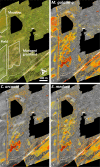Mark-release-recapture meets Species Distribution Models: Identifying micro-habitats of grassland butterflies in agricultural landscapes
- PMID: 30485301
- PMCID: PMC6261544
- DOI: 10.1371/journal.pone.0207052
Mark-release-recapture meets Species Distribution Models: Identifying micro-habitats of grassland butterflies in agricultural landscapes
Abstract
Habitat demands and species mobility strongly determine the occurrence of species. Sedentary species with specific habitat requirements are assumed to occur more patchy than mobile habitat generalist species, and thus suffer stronger under habitat fragmentation and habitat deterioration. In this study we measured dispersal and habitat preference of three selected butterfly species using mark-release-recapture technique. We used data on species abundance to calculate Species Distribution Models based on high-resolution aerial photographs taken using RGB / NIR cameras mounted on a UAV. We found that microhabitats for species with specific habitat requirements occur spatially restricted. In contrast, suitable habitats are more interconnected and widespread for mobile habitat generalists. Our models indicate that even managed grassland sites have comparatively little habitat quality, while road verges provide high quality micro-habitats. In addition, dispersal was more restricted for specialist butterfly species, and higher for the two other butterfly species with less ecological specialisation. This study shows synergies arising when combining ecological data with high precision aerial pictures and Species Distribution Models, to identify micro-habitats for butterflies. This approach might be suitable to identify and conserve high quality habitats, and to improve nature conservation at the ground.
Conflict of interest statement
The authors have declared that no competing interests exist.
Figures
Similar articles
-
Roads affect the spatial structure of butterfly communities in grassland patches.PeerJ. 2018 Aug 14;6:e5413. doi: 10.7717/peerj.5413. eCollection 2018. PeerJ. 2018. PMID: 30128196 Free PMC article.
-
Landscape composition and habitat area affects butterfly species richness in semi-natural grasslands.Oecologia. 2006 Sep;149(3):526-34. doi: 10.1007/s00442-006-0464-6. Epub 2006 Jun 15. Oecologia. 2006. PMID: 16775707
-
Well-managed grassland heterogeneity promotes butterfly conservation in a corridor network.J Environ Manage. 2019 May 15;238:382-395. doi: 10.1016/j.jenvman.2019.03.021. Epub 2019 Mar 9. J Environ Manage. 2019. PMID: 30861399
-
Movement and Demography of At-Risk Butterflies: Building Blocks for Conservation.Annu Rev Entomol. 2019 Jan 7;64:167-184. doi: 10.1146/annurev-ento-011118-112204. Epub 2018 Oct 8. Annu Rev Entomol. 2019. PMID: 30296858 Review.
-
A meta-analysis of dispersal in butterflies.Biol Rev Camb Philos Soc. 2010 Aug;85(3):625-42. doi: 10.1111/j.1469-185X.2009.00119.x. Epub 2010 Jan 5. Biol Rev Camb Philos Soc. 2010. PMID: 20055815 Review.
Cited by
-
Modelling sexually deceptive orchid species distributions under future climates: the importance of plant-pollinator interactions.Sci Rep. 2020 Jun 30;10(1):10623. doi: 10.1038/s41598-020-67491-8. Sci Rep. 2020. PMID: 32606363 Free PMC article.
References
-
- Dennis RLH, Eales HT (1997) Patch occupancy in Coenonympha tullia (Muller, 1764) (Lepidoptera: Satyrinae): habitat quality matters as much as patch size and isolation. J Insect Conserv 1: 167–176.
-
- Habel JC, Rödder D, Lens L, Schmitt T (2013) The genetic signature of ecologically different grassland Lepidopterans. Biodiv Conserv 22: 2401–2411.
-
- Batáry P, Gallé R, Riesch F, Fischer C, Dormann CF, Mußhoff O et al. (2017) The former Iron Curtain still drives biodiversity–profit trade-offs in German agriculture. Nature Ecol Evol 1: 1279–1284. - PubMed
-
- Stevens CJ, Dise NB, Mountford JO, Gowing DJ (2004) Impact of nitrogen deposition on the species richness of grasslands. Science 303: 1876–1879. 10.1126/science.1094678 - DOI - PubMed
-
- Geiger F, Bengtsson J, Berendse F, Weisser WW, Emmerson M, Morales MB et al. (2010) Persistent negative effects of pesticides on biodiversity and biological control potential on European farmland. Basic Appl Ecol 11: 97–105.
MeSH terms
LinkOut - more resources
Full Text Sources
Miscellaneous


